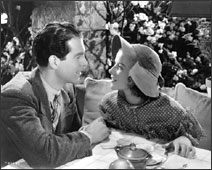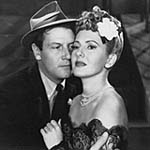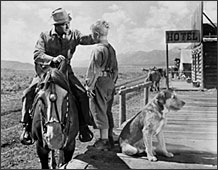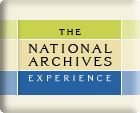October 2004: Honoring Guggenheim, Celebrating Stevens
 |
| Katharine Hepburn and Fred MacMurray in George Stevens's film Alice Adams (Courtesy A.M.P.A.S.) |
The National Archives had no greater supporter than the late documentary filmmaker Charles Guggenheim. Guggenheim's career spanned half a century. He made more than 100 documentaries, was nominated for 12 Academy Awards, and won four times. Guggenheim also received the prestigious George Foster Peabody Award and three Emmys. He is considered by many to be one of the central figures in the founding and evolution of the American documentary.
Guggenheim relied on the National Archives' phenomenal holdings of photographs and films in the creation of his work. His interest in preservation and access to these records led him to accept a seat on the board of directors of the Foundation for the National Archives. He spent his final years in service as president of the Foundation and led the initial effort to develop the National Archives Experience. Guggenheim's depository of more than 500 film titles will be housed and preserved at the John F. Kennedy Library in Boston and at the Academy of Motion Picture Arts and Sciences Archive in Los Angeles.
The Foundation and the National Archives, in a tribute to the work and dedication of Charles Guggenheim, recently announced the Charles Guggenheim Center for the Documentary Film. The mission of the Guggenheim Center will be to advance public understanding of the process, challenges, and impact of documentary filmmaking and to promote the education of young people and professionals in film documentation. The Center will be both a living legacy of an internationally acclaimed producer and director and an extension of America's premier resource for documentary film research.
 |
| Joel McCrea and Jean Arthur find love in wartime Washington, DC, in The More the Merrier. (Courtesy A.M.P.A.S.) |
The premier program to be offered at the Guggenheim Center is a celebration of the centennial of Guggenheim's fellow director and World War II veteran, George Stevens. The program is the first in a series of presentations in a new partnership between the Foundation for the National Archives and the Academy of Motion Picture Arts and Sciences.
Born on December 18, 1904, in Oakland, CA, George Stevens began working in the film industry as a cameraman during the 1920s, shooting comedies, including Laurel and Hardy films, at the Hal Roach studio. Stevens went on to direct Katharine Hepburn in the 1935 film Alice Adams, which proved he had a range beyond the strictly comedic.
Stevens headed a combat motion picture unit under Gen. Dwight Eisenhower from 1944 to 1946 and was awarded the Legion of Merit for his service. Footage from Stevens's World War II unit, which includes unique color film, is part of the holdings of the National Archives.
 |
| Alan Ladd and Brandon deWilde in Shane. (Courtesy A.M.P.A.S.) |
Stevens's mastery of his craft extended over more than four decades, and four of his films, Swing Time, Gunga Din, Woman of the Year, and Shane, have come to be regarded as classic examples of their respective genres.
Stevens received five Academy Award nominations for directing. As a producer, Stevens was nominated for four Oscars® when A Place in the Sun, Giant, Shane, and The Diary of Anne Frank were named best picture nominees in their respective years. Stevens also received the Irving G. Thalberg Memorial Award in 1953 and served as president of the Academy from 1958 to 1959.
PDF files require the free Adobe Reader.
More information on Adobe Acrobat PDF files is available on our Accessibility page.
